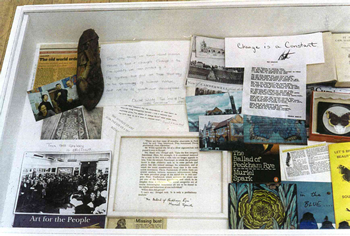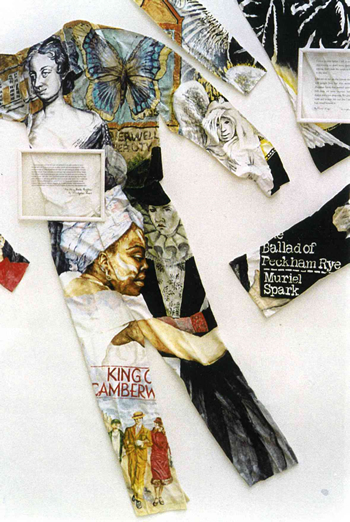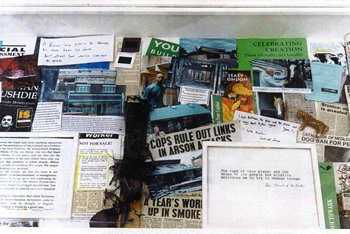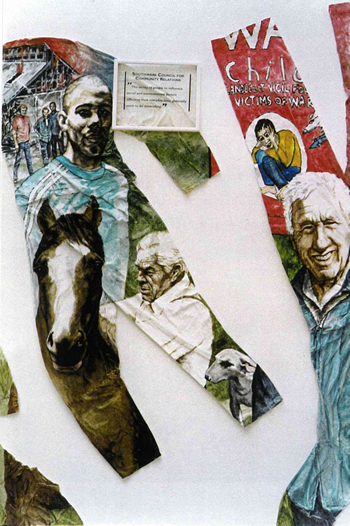“ARENA FOR CONVERSATION” 1994

CONVERSATION SERIES 1991 – 1994
On arrival at each of my four artist’s residencies in Canada and Britain I began by creating an initial installation in the gallery space in the week before my public live work began. This always contained a site-specific object of local significance, a ‘conversation piece’ to encourage a one-to-one dialogue with individual visitors. At the South London Gallery I asked for the original Victorian Arts and Crafts inlaid floor to be uncovered, bearing the words “The source of art is in the life of a people”.
One-to-one conversations in the gallery itself concentrated on the life-changing private experiences of each visitor and through this their primary public concerns. For three weeks at each site I listened every day to these poignant stories of significant life-events, often by immigrants from a multitude of countries. I then asked each visitor to return with a related personal memento to contribute to the long glass display cases as part of the work. These were all gradually arranged in the four cases to visually focus on the broader issues of paternalism, colonialism, imperialism and racism. These personal items formed the direct source material for my continuous painting activity on the walls of the gallery every evening after closing.

Each morning I also undertook a series of outreach meetings with people who were essential members of organisations and groups committed to supporting very needy parts of the community, but who rarely if ever had entered the gallery. I had asked the gallery staff to identify these key local people in advance of my arrival and arrange formal appointments for me go to meet them at their place of work.
On meeting I first asked them to describe exactly what they did, which often revealed years of prolonged but seemingly endless attempts to help the ill, the poor, the dispossessed, the abused or the addicted. I then asked what had led them to do this. This second question frequently uncovered a past moment of personal trauma in their own life, which they had overcome but had led them to want to help others. After listening to each moving personal story, I then asked how their resulting work now made them feel about their own future.


This question was often met with upset or tears at the unremitting emotional cost of their continuous struggle. Finally I asked if they had a related text, image or object, a thing of personal significance that they felt had helped them to overcome their original negative life-experience, and invited them to bring it to the gallery. Many people did this and then returned again and again, at first celebrating the public place of their anonymous private experience as part of the artwork display, later, sometimes with great joy, its representation in a painted image or as a framed text quoted on the walls.


Unexpectedly this process, the sharing of a hidden private experience with the larger community through art, was occasionally followed at each gallery by an unprompted radical decision to change their own life for the better, to create a more positive future for themselves, as well as for others. In Camberwell, one rather sombre man, a South African who was a senior Council officer, revealed that for years he had tolerated apparently trivial racial jibes from his colleagues but how he felt hugely undermined and undervalued by this. He only became animated when he spoke of the recent appointment of Nelson Mandela. But two weeks later he excitedly told me that he was going back home to offer his work skills to help build the future of his own country. It seems that for some the gallery installation had provided the mental space to design a more optimistic future for themselves.
Rose Garrard 1998
CONVERSATION SERIES 1991-1994 at:
The New Art Gallery, Calgary- “Calgary Conversation”, 1991,
The Vancouver Art Gallery - “Disclosing Dialogues”, 1992,
Manchester Cornerhouse Gallery - “Exchanges for Empowerment, 1994,
South London Gallery - “Arena for Conversation”, 1994.